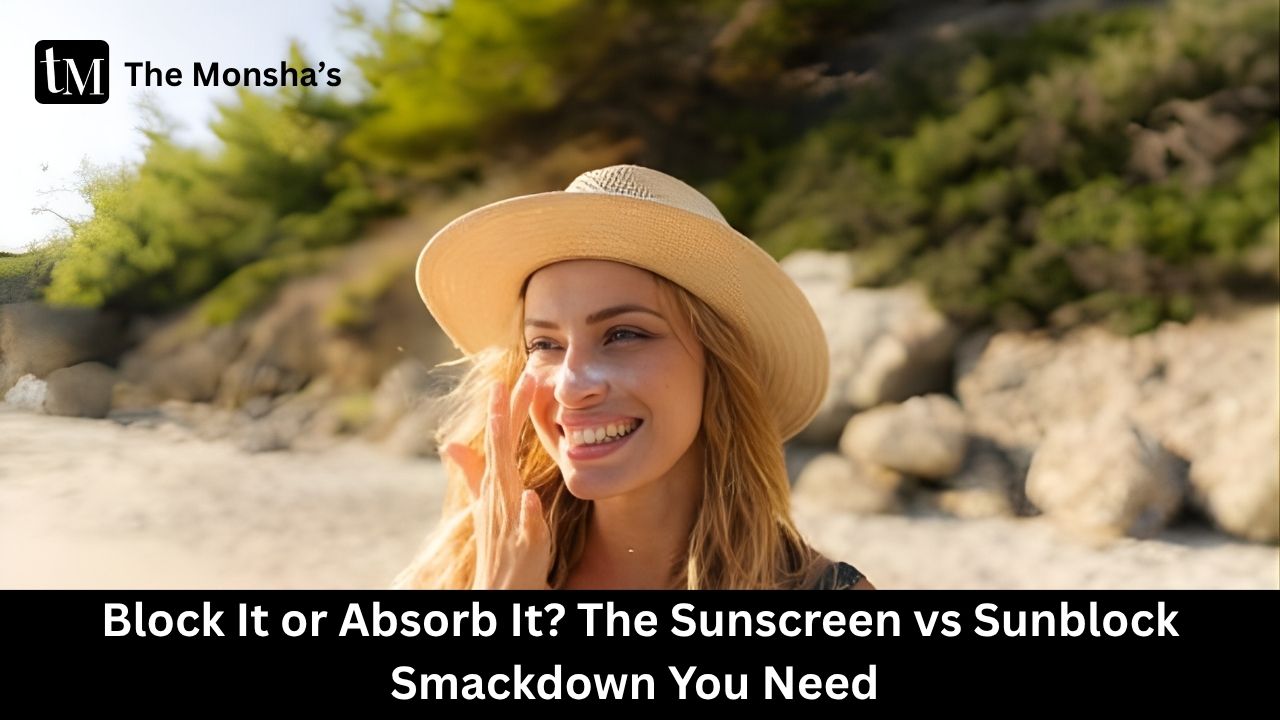“Suraj se dosti bhi nahi aur dushmani bhi nahi… SPF lagana toh banta hai bhai!” 🎶Ever stood in a store aisle squinting at “sunscreen” and “sunblock” wondering if they’re just marketing twins? Or maybe you bought a “sunblock” thinking you’d be invisible to UV rays — only to return from Goa two shades darker? Been there.
Let’s break down the real differences, the benefits of each, and how to pick the best shield for your skin. No jargon, no fear-mongering — just facts with a splash of desi wit.
What Exactly Are Sunscreen & Sunblock? 🧴
Although brands often use them interchangeably, there’s a science-backed difference:
- Sunscreen (Chemical): Contains filters like avobenzone, octocrylene, oxybenzone that absorb UV rays and convert them into heat. Think of it as a sponge soaking up UV.
- Sunblock (Mineral / Physical): Uses zinc oxide or titanium dioxide to sit on top of skin and reflect/scatter UV rays. Think of it as a tiny shield deflecting rays away.
Regulatory bodies worldwide now mostly use “sunscreen” as an umbrella term. “Sunblock” as a label is being phased out, but people still use it to mean mineral-based formulas.
Key Differences — Ingredient, Mechanism & Texture ⚖️

💡 No formula blocks 100% UV rays. Reapplication is your BFF.
Benefits & Limitations 🌞
Sunscreen (Chemical) Benefits
- Lightweight, no white cast — great under makeup
- Offers broad-spectrum protection (UVA + UVB) in many new formulas
- Easy to find water-resistant options
Sunscreen Drawbacks
- Can irritate sensitive skin or eyes
- Some filters not reef-safe (environmental concern)
Sunblock (Mineral) Benefits
- Better tolerated by sensitive skin, eczema-prone or post-procedure
- Works instantly on application
- More stable in sunlight
Sunblock Drawbacks
- Thicker texture, may leave white cast on deeper tones
- Fewer water-resistant options
How to Choose — Match With Your Skin & Lifestyle 🧠
Sensitive or Reactive Skin
Choose mineral (sunblock) with zinc oxide/titanium dioxide — lower irritation risk.
Oily / Acne-Prone Skin
Go for lightweight chemical or hybrid formulas labeled non-comedogenic.
Daily Office / Indoor Use
Light chemical sunscreen or hybrid works — easy under makeup.
Beach, Trek, Outdoor Sports
Opt for water-resistant mineral or hybrid with SPF 30–50, PA+++ or more.
Kids & Post-Procedure Skin
Stick to mineral sunblocks recommended by dermatologists.
Application Tips & Best Practices 📝
- Amount matters: 2 finger-lengths for face + neck.
- Apply 15–20 minutes before sun if using chemical sunscreen.
- Reapply every 2 hours or after swimming/sweating.
- Don’t forget ears, back of neck, hands, and lips.
- Hats, scarves, and shade = your bonus defense.
Research consistently shows the biggest reason sunscreens “fail” is under-application and lack of reapplication, not the filter type itself.
Side Effects, Myths & Misconceptions 🤯
- ❌ Myth: “Sunblock = full block, no reapplication.”✔ Reality: All filters degrade with time, sweat, and sun.
- ❌ Myth: “Mineral = no white cast.”✔ Reality: New micronized formulas reduce it but not eliminate.
- ❌ Myth: “High SPF = total protection.”✔ Reality: SPF only measures UVB; UVA protection needs PA+++ rating.
Environmental note: Choose reef-safe formulas if swimming outdoors.
The Monsha’s Smart Recommendation 🌸
At The Monsha’s, our skincare experts often recommend mineral-based sunscreens for sensitive clients and hybrid formulas for makeup lovers. And yes, we integrate SPF advice into our at-home facials and detan treatments.
📍 Delhi NCR | Gurgaon | Noida
TL;DR 📝
- Sunscreen (chemical) absorbs UV rays; sunblock (mineral) reflects them.
- Sunscreen = lighter, invisible, but may irritate. Sunblock = gentler, thicker, instant.
- No SPF blocks all UV rays. Amount + reapplication > type.
- Sensitive skin = mineral. Daily indoor = chemical or hybrid. Outdoor = water-resistant high SPF.
FAQs 🙋♀️
Is “sunblock” still a valid term?
It’s being phased out in labeling but still means mineral-based products.
Can I mix sunscreen + sunblock together?
You can layer, but usually one good broad-spectrum product is enough.
Does mineral protect against UVA as well as UVB?
Yes — zinc oxide especially covers UVA + UVB.
How often should I reapply?
Every 2 hours or after sweating/swimming, regardless of type.
Which is better for kids?
Dermatologists recommend mineral (sunblock) for babies and young kids.

